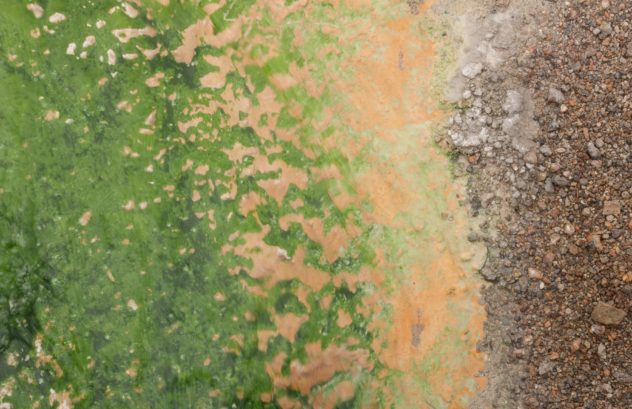Vocabulary:
- debris /duh-BREE/
- ground zero /ground-ZEro/
- restore /ri-STAWR/
- sediment /SED-uh-muhnt/
- accumulate /uh-KYOO-myuh-leyt/
[noun] broken or torn pieces left from the destruction of something larger
Several people were injured by the debris from a recent explosion.
[noun] the very beginning
It’s hard to start at ground zero to work and gain all the knowledge when you want it all right away.
[verb] to bring something back into existence
After the long wait, peace has finally been restored to the region.
[noun] solid material, such as dirt or minerals, that falls to the bottom of a liquid
There were some brown sediments on the bottom of the glass bottle.
[verb] to gradually increase in number or amount
You know it’s time for spring cleaning once dust accumulates on the windowsill.
A smoldering crater, known as Chicxulub, left by a space rock that struck Earth 66 million years ago, reportedly became a home for blue-green algae. Photosynthesis shut down after the incident heaved a large amount of debris into the atmosphere. Years after the impact, the blue-green algae carrying toxic blooms moved to the crater along with cyanobacteria that can produce food on their own. This proved that life at ground zero can be restored in a short period of time. The crater that is approximately 20 miles in depth resulted in the formation of the Gulf of Mexico.
In 2016, geologists unearthed a 2,750-foot-long foundation of sediments from Chicxulub, permitting scientists around the world to examine the rocks. Ms. Bettina Schaefer, a scientist from the Curtin University of Australia, focused on how life at ground zero rebounded. Ms. Schaefer’s team found preserved fats within the core of the sedimentary rocks, which means that cyanobacteria are present. According to their research, the fats accumulated on top of layered, fossilized plants that were then carried away to the crater by the tsunami. This means that the bacteria inhabited the crater in the aftermath of the tsunami, but prior to the atmosphere’s clearing and the sunlight’s restoration.
In 2016, geologists unearthed a 2,750-foot-long foundation of sediments from Chicxulub, permitting scientists around the world to examine the rocks. Ms. Bettina Schaefer, a scientist from the Curtin University of Australia, focused on how life at ground zero rebounded. Ms. Schaefer’s team found preserved fats within the core of the sedimentary rocks, which means that cyanobacteria are present. According to their research, the fats accumulated on top of layered, fossilized plants that were then carried away to the crater by the tsunami. This means that the bacteria inhabited the crater in the aftermath of the tsunami, but prior to the atmosphere’s clearing and the sunlight’s restoration.
True or False:
- The event caused too much debris in the atmosphere that photosynthesis shut down.
- The blue-algae moved into the crater together with the impact.
- Based on the article, life could return even at ground zero within a short period of time.
- Scientists all over the world were able to study the rocks excavated from the crater.
- According to research, the fats of sedimentary rocks formed below fossilized plants.
Discussion Questions:
- Do you think Earth will soon be back at ground zero? Please explain your answer.
- In your opinion, is it possible for other bacteria to create life from scratch? Why or why not?
- What activities do you think are destroying Earth?
- Do you think there is another planet like Earth? Please explain your answer.
- What are your thoughts about “another Earth”?
Express Your Opinion:
- “Once you make a decision, the universe conspires to make it happen”. – Ralph Waldo Emerson
- “The universe is not outside of you. Look inside yourself; everything you want, you already are”. – Rumi
- “The universe doesn’t give you what you ask for with your thoughts, it gives you what you demand with your actions.” – Steve Maraboli
